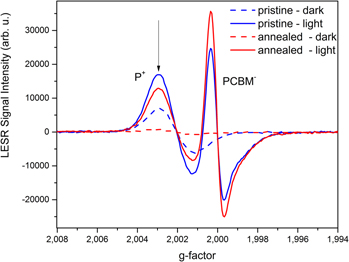Article contents
Degradation kinetics in different polymer–fullerene blends investigated by electron spin resonance
Published online by Cambridge University Press: 13 July 2018
Abstract

We investigate the photostability of a set of organic semiconductor blends comprising a conjugated polymer as the donor and a fullerene as the acceptor using electron spin resonance (ESR). In the absence of oxygen, all blends show excellent stability. Even after several hundred hours of exposure to solar or UV radiation, the ESR spectra and the recombination of photoinduced charges recorded at low temperature are found to be unchanged. By contrast, the presence of oxygen leads to a fast light-induced degradation rendering the ability of the donor/acceptor system to form photoinduced charge carriers. Our findings suggest that conjugated polymer–fullerene blends exhibit very good photostability and that oxygen needs to be excluded in optoelectronic applications. Our findings also suggest that at low temperature, a universal recombination process of long-lived photoinduced charges is active, which does not depend on the electronic structure or the morphology of the investigated materials.
Keywords
- Type
- Invited Article
- Information
- Journal of Materials Research , Volume 33 , Issue 13: Focus Issue: Stabilization of Organic Electronic Materials and Devices , 14 July 2018 , pp. 1853 - 1859
- Copyright
- Copyright © Materials Research Society 2018
References
REFERENCES
- 9
- Cited by




